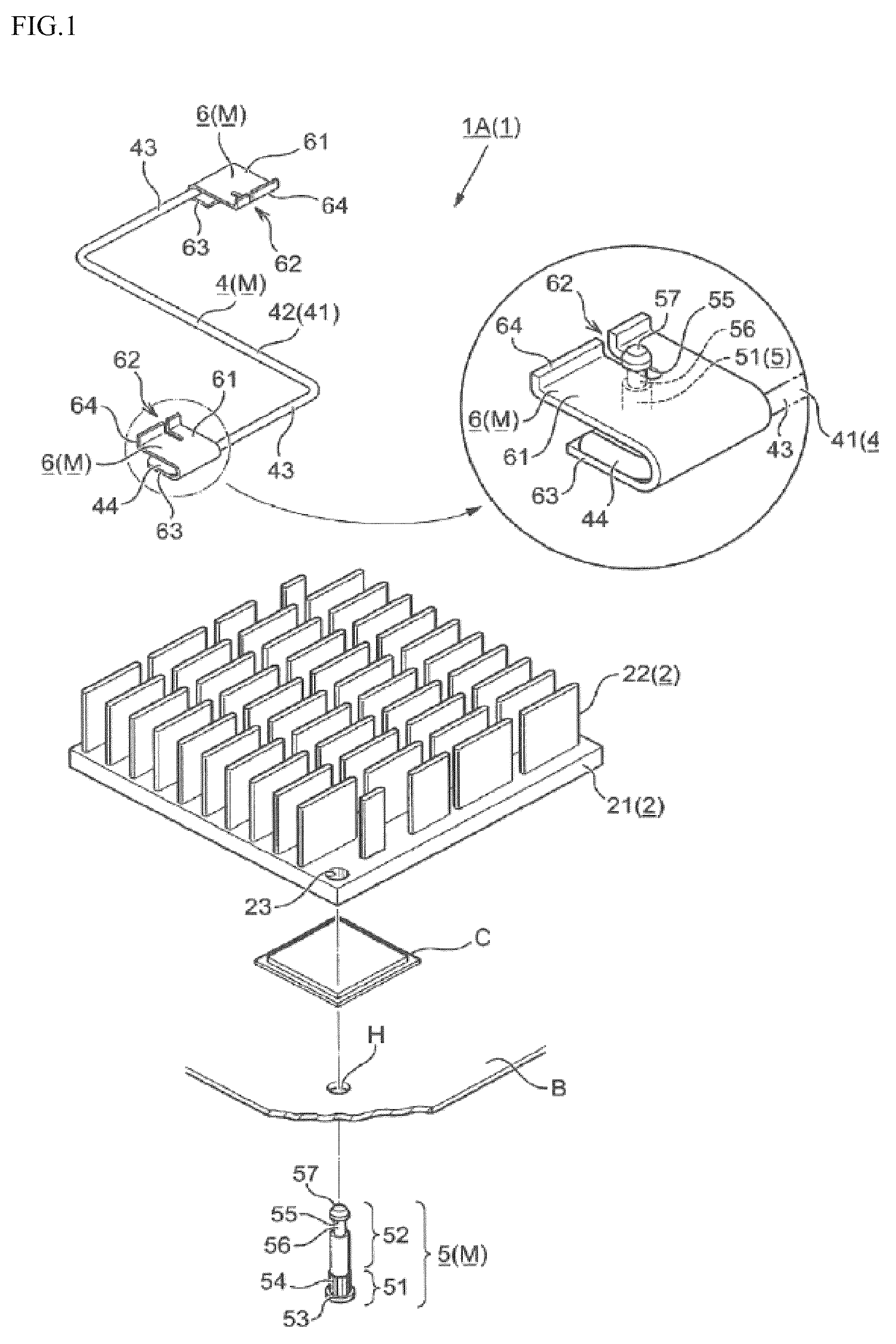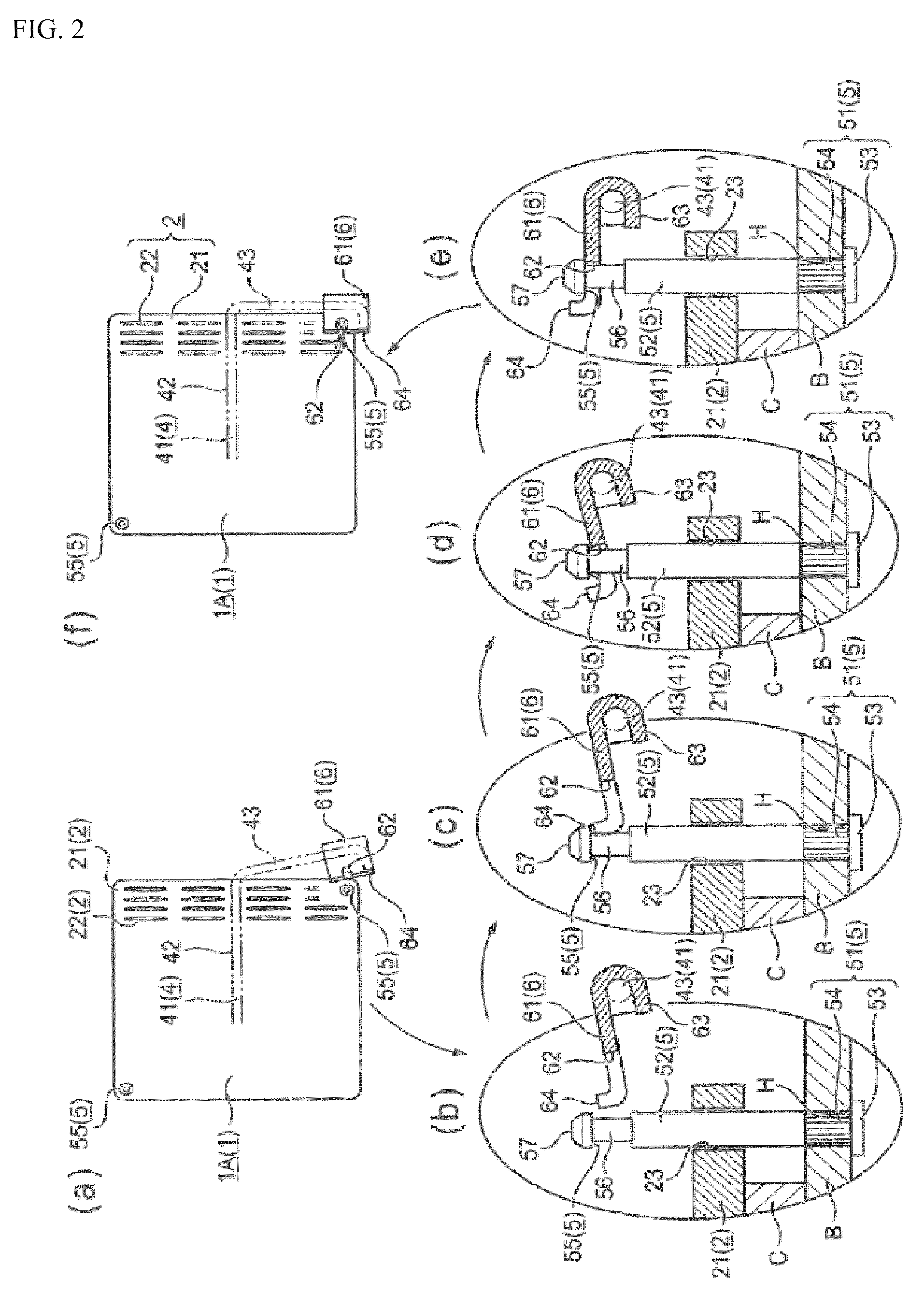Structure for mounting heat sink, and heat sink mounted using the structure
a technology for mounting structures and heat sinks, which is applied in the direction of electrical apparatus casings/cabinets/drawers, instruments, and semiconductor/solid-state device details, etc., can solve the problems of difficult work for forming the slit-like openings shown in fig. 17(a)/i>a), and achieve the effect of preventing the anchor from falling off, ensuring the mounting of the heat sink, and effective utilization of the circuit board surfa
- Summary
- Abstract
- Description
- Claims
- Application Information
AI Technical Summary
Benefits of technology
Problems solved by technology
Method used
Image
Examples
first embodiment
[0073]As a basic form of the heat sink 1 (1A) in a first embodiment, the attachment pieces 6 are formed separately from the wire spring 41 and the attachment pieces 6 and the wire spring 41 are joined by welding or the like later. The heat sink 1A in the first embodiment mainly includes, as shown in FIG. 1 as an example, a heat sink body 2 that performs heat radiating action and mounting means M for mounting the heat sink body 2 on the circuit board B. These members are explained below.
[0074]The heat sink body 2 is formed of a material excellent in thermal conductivity and heat radiation properties such as aluminum. The heat sink body 2 has a basis structure in which a large number of heat radiation fins 22 are formed to be projected from a tabular base 21.
[0075]In the base 21, a surface on which the heat radiation fins 22 are not formed is a contact surface that is compression-bonded (closely attached) to the semiconductor circuit elements C. In general, a thermal conductive sheet ...
second embodiment
[0111]Next, the heat sink 1 (1B) in a second embodiment is explained.
[0112]The heat sink 1B in the second embodiment basically follows the structure of the first embodiment. However, the heat sink 1B is different in points explained below. In the first embodiment, the attachment pieces 6 are provided in the fixed state with respect to the wire spring 41. However, in the second embodiment, the attachment pieces 6 are provided in a movable state with respect to the wire spring 41. The attachment pieces 6 are provided in the movable state with respect to the wire spring 41 in this embodiment because of consideration (intension) that a movable range further expands (a degree of freedom of movability increases) according to the movement of the attachment pieces 6 (movability with respect to the wire spring 41) in addition to the movement due to bending, twisting, and the like by the wire spring 41 and the mounting work can be more surely and more easily performed.
[0113]Examples of such a...
third embodiment
[0120]Next, the heat sink 1 (1C) in a third embodiment is explained.
[0121]The heat sink 1C in the third embodiment includes, as shown in FIG. 8(a) as an example, the attachment pieces 6 of a push nut type. The attachment pieces 6 are forcibly fit in the attaching sections 55 (the anchor heads) of the anchors 5 to mount the heat sink body 2. The attachment pieces 6 of the push nut type in this embodiment are different from the embodiments 1 and 2 in the structure and a mounting form (a fitting form) of the attachment pieces 6. Therefore, the attachment pieces 6 are hereinafter referred to as “attachment pieces 6C” following the end sign of the heat sink 1C.
[0122]In the attachment pieces 6C in this embodiment, because of the structure explained above, insertion holes 71 fit over the attaching sections 55 of the anchors 5 therein are formed. Returns 72 having a reverse claw shape are formed on both sides of the insertion holes 71. To obtain the mounted state, the insertion holes 71 of ...
PUM
 Login to View More
Login to View More Abstract
Description
Claims
Application Information
 Login to View More
Login to View More - R&D
- Intellectual Property
- Life Sciences
- Materials
- Tech Scout
- Unparalleled Data Quality
- Higher Quality Content
- 60% Fewer Hallucinations
Browse by: Latest US Patents, China's latest patents, Technical Efficacy Thesaurus, Application Domain, Technology Topic, Popular Technical Reports.
© 2025 PatSnap. All rights reserved.Legal|Privacy policy|Modern Slavery Act Transparency Statement|Sitemap|About US| Contact US: help@patsnap.com



